Places Visited: Wyoming: Jackson, and Jackson Hole.
Idaho: Swan
Valley, Palisades and Palisades Dam & Reservoir.
July 28 & 29, 2006:
Virginian RV-Park-Park in Jackson, WY 307-733-7189 N43° 28.328' W110°
46.721 $52.47 Full hookups with 50-amps. Gravel interior roads and pads. Nice,
clean park---the Virginian is "The" RV-Park in Jackson.
We moved
the motorhome from Idaho Falls, Idaho to Jackson, Wyoming today. The majority
of the Idaho portion of this drive is covered in the previous travelogue. I started
this one somewhere near Swan Valley, Idaho which is not far from the Wyoming border
on US-26.
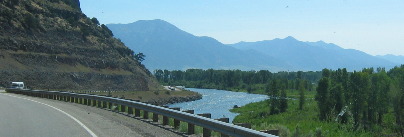
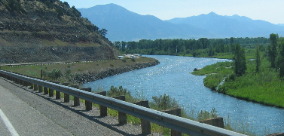
The
Snake River is our companion as we travel east on US-26 around Swan Valley, Idaho.
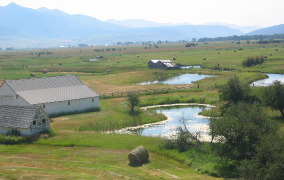
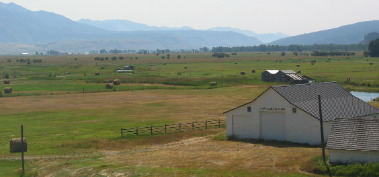
A
broad beautiful valley stretches before us as we traverse Swan Valley, Idaho.
Between
Swan Valley and Palisades US-26 follows this beautiful valley carved by the Snake
River, I don't know if it remains the Swan Valley for the entire length or changes
name somewhere along the way.
Once into Wyoming we start following
the Snake River north to Jackson--some refer to it as Jackson Hole. We will discuss
Jackson & Jackson Hole a little later. Until that time see if you know the
difference.
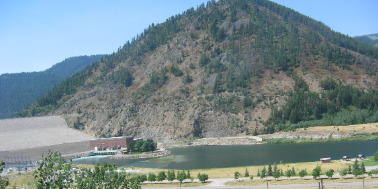
While
we were following the Snake River upstream the scene suddenly changed when we
came upon the Palisades Dam, Reservoir and electric generating facility.
East
of Palisades, the huge Palisades Dam has impounded the Snake River into giant
Palisades Reservoir that stretches 20-some odd miles to the east and into Wyoming.
In addition to providing irrigation water for Idaho farmers a hydroelectric generating
plant is providing electricity needs to the area.
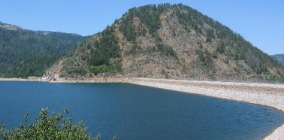
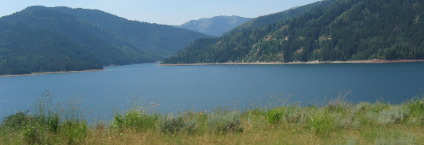
The
Palisades Dam is holding back a tremendous Reservoir full of water. In fact the
reservoir appears to be over 20-miles long stretching to the southeast into western
Wyoming.
The South Fork of the Snake River and Palisades Reservoir
provide some of the most outstanding native cutthroat trout fisheries in the West.
Populations of colorful cutthroat trout and whitefish are native to these waters.
To Supplement the fisheries, brown trout are stocked annually.
Osprey and
eagles may be seen soaring overhead as they search the reservoir for fish. Their
major source of food.
The Timbered slopes adjacent to the reservoir are
important to the osprey and eagle for nesting. These birds of prey build their
nest within view of water and generally return to them year after year.
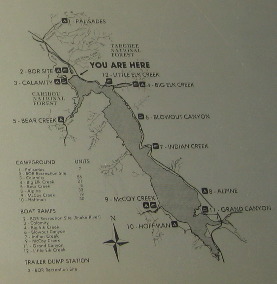
We
are located at the northwest end of Palisades reservoir. The dam is located at
the northwest end of this huge reservoir and that is where we took took the above
pictures.
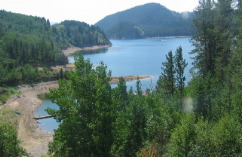
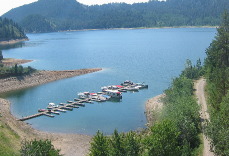
US-26
follows the northern shore of Palisades Reservoir as we travel east on US-26.
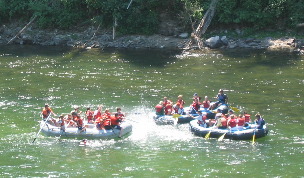
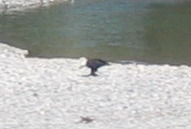
Once
in Wyoming we turn north following the Snake River toward Jackson. Hoards of rafters
fill the river. Joyce snapped this picture of a bald eagle enjoying a fish dinner
on a sandbar in the river.
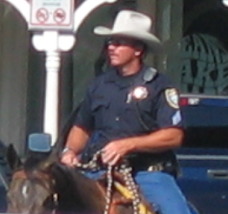
I
snapped the following pictures "on-the-square" in downtown Jackson while
riding a bench as Joyce strolled through the trendy shops.
This mounted
uniformed officer seemed to be more for show and PR than law enforcement.
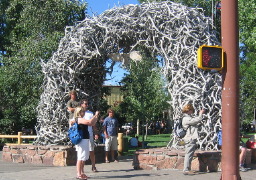
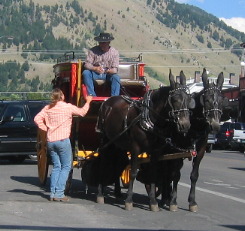
The
elk antler arches adorning each corner of Jackson Square is their trademark. This
stagecoach offeres rides around the square and does a brisk business. Today the
stage is being powered by "mule power" other day draft horses are employed.
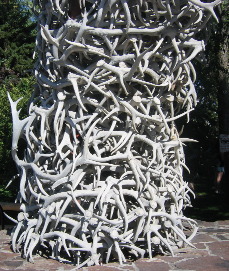
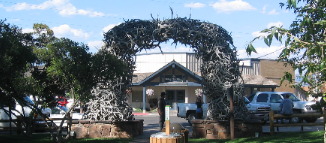
The
elk antler arches are a unique thing and everyone seems to love them.
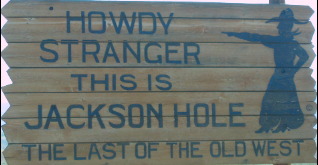
While
this is a cute welcome sign located at the Jackson airport this is hardly the
"last of the old west". It would be more appropriate to advertise Jackson
as a millionaires roost.
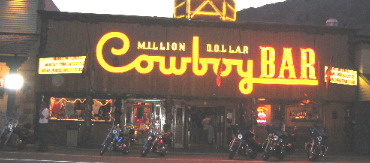
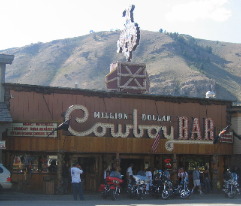
It
doesn't matter whether it is 12-noon or 12-midnight the Million Dollar Cowboy
Bar is hopping. It is more than just a bar, it is an institution. They feature
top notch bands every night of the week and pack the place with individuals that
like to dance. When the band isn't playing the place is still packed. One night,
while we were there, a bride spent the evening in there in her wedding dress.
On several occasions there were bridal parties and bachelor parties in the place.
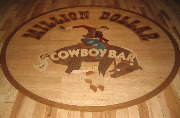
Joyce tried to wear this inlayed emblem off the dance floor. I can
tell you that more determined individuals than Joyce have tried and failed. VBG
----- We had a great time on this dance floor while were staying in Jackson and
again when we were in Gros Ventre Campground just north of Jackson.
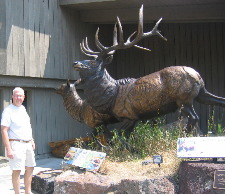
We
always stop by the Information Center in Jackson to refresh ourselves on the Elk
Refuge. At nearly 20-million acres the Greater Yellowstone Ecosystem (GYE), is
one of the largest expanses of wild lands anywhere. The GYE is comprised of three
national wildlife refuges, two national parks, seven national forests plus other
state, federal and private lands. This amazing ecosystem provides key habitats
for at least 47 different species of mammals, over 280 species of birds, and numerous
other wildlife species.

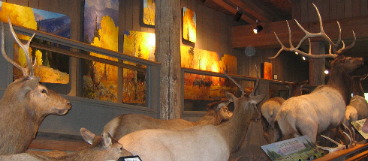
Inside
the Information Center this herd of elk moving up a hill totally consumes the
senses of visitors. This is one of several dioramas in the center that command
your attention.
The high-mountain habitats that supply lush
grasses to fatten up summering elk become frozen and snow-covered in harsh winters.
Elk must move to lower elevations to find their winter food, following long-established
migration routes down to the valleys. Some of these elk will travel up to 100-miles
between their summer and winter ranges.
Elk communicate constantly, using
vocalizations and body language as they travel, watch for danger and share foraging
areas. The fall bugling of a bull elk is the species' most distinctive call, but
bulls, cows and calves also use a variety of mews, chirps and barks to communicate
with each other.
Made of fast-growing bone, antlers are shed and regrown
every year. During the summer when food is plentiful, velvet covered anglers can
grow as fast as an inch per-day. Only the male animals in the deer family grow
antlers, except for female caribou.
Bull elk wear their antlers proudly
as a sign of fitness. Antlers indicate to cows which bulls are the healthiest
and strongest, and can pass those traits on to calves. During the fall breeding
season, or rut, bulls display their antlers to other bulls to establish their
rank. Antlers can become sparring weapons in a duel for dominance.
Antlers,
unlike true horns, are shed annually in the late winter, and a complete new "rack"
is grown each season.
Antlers come in all sizes and shapes royals, raghorns
and spikes are some of the differences. Do six points (or tines) mean a bull elk
is six-years-old? Not necessarily. The size and shape of antlers is related to
a bull's habitat, health, genetics and age. Antlers generally do get larger as
a bull gets older. A large bull with six points is sometimes referred to as a
"royal" bull, at least six or seven years old. Bulls in the two and
three year-old range grow smaller, branched antlers, nicknamed "raghorns."
Yearling bulls usually sprout "spikes," straight single antlers, maybe
with a fork.
Elk are built for survival. Elk are wary and secretive animals
gifted with large, swiveling ears and sensitive noses to pick up sounds and scents
from great distances. Armed with keen eyesight and eyes positioned on the sides
of their heads, elk can detect potential danger from almost any direction.
An
elk's two-layer winter coat is five times warmer than its summer hair, helping
it to stay warm even freezing temperatures.
Obeying their keen instincts,
elk rely on long, lean leg muscles and sharp hooves to race away from danger at
speeds of up to 35-miles per-hour.
Adult bull elk can weigh more than 800-pounds,
stand 5' at the shoulder, and measure 8' from nose to rump. Their formidable antlers,
hooves and sheer size are a serious deterrent to most predators.
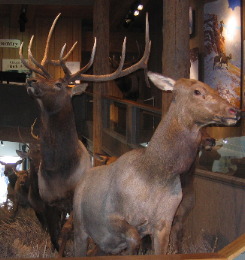
This
is another view of that elk herd in the Information Center. Totally awesome is
the only way to describe it.
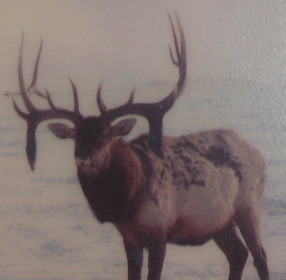
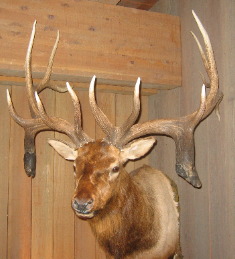
Antlers
on this bull are "sheds." Collected on the National Elk Refuge. This
bull wintered on the Refuge for several years, shedding similar "double drop"
point antlers each season. Matching double drops are extremely rare. Occasionally
does a bull with a single drop antler winter on the Refuge.
It is believed
that this condition is genetic. The black material is the dried skin that surrounds
the antler, called velvet, which the bull was not able to rub off. This bull was
scored and had a Boone & Crockett Non-Typical score of about 350.
Quality
winter habitat is important to wildlife because food is much harder to find and
cold weather drains energy. As Jackson Hole developed, the Jackson elk herd lost
about three-fourths of its traditional winter range and some of its major migration
corridors. State and federal wildlife agencies now manage and protect the last
of this valley's winter habitat and its magnificent elk herd.
When elk deplete
the refuge's limited winter forage, they are fed hay or alfalfa pellets. This
solution, which can lead to the spread of diseases, overpopulation and other unnatural
complications, is far from ideal. The National Elk Refuge, its partners and neighbors
are working to limit the need for feeding elk by protecting and improving their
natural habitat.
The National Elk Refuge allows limited hunting to help
manage and maintain the wintering elk populations and protect elk winter range.
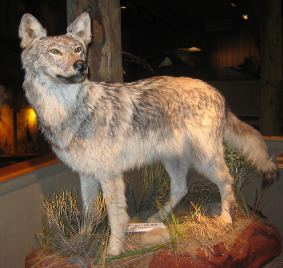
This
is a beautiful wolf mount on display in the Information Center.

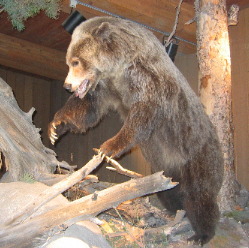
The
Information Center also sports this magnificent elk antler chandelier and this
big bear.
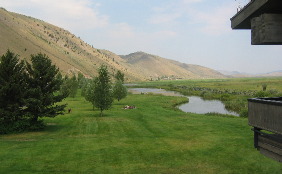
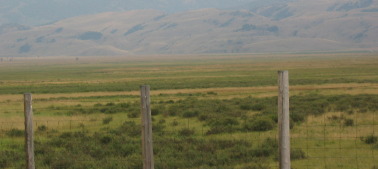
Near
the Information Center the lush green grass and marsh area is home to myriad nesting
ducks and several pair of trumpeter swans. Further north this fence shields the
highway from the elk refuge as much for motorist safety as to protect the thousands
of elk that winter here.

We
took these pictures of the elk refuge from half-way up the mountain that borders
the western side of the elk refuge. The one on the left is facing south and is
the greenest portion of the refuge. The city of Jackson anchors the southern end
of the elk refuge and can be seen at the bottom of the mountain with those ski
runs. Those ski runs are at Snow King Resort in downtown Jackson. The picture
on the right is of the northern portion of the refuge. If you look closely you
can see the large fence that runs along the highway leading to Teton and Yellowstone
National Parks.
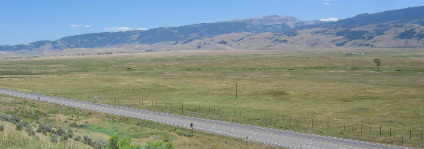
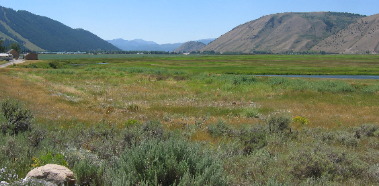
This
picture was taken with the elk refuge in the foreground, and Jackson in the center
background. Where the pictures above were taken from the west side of the refuge
looking south this picture was taken from the east side of the refuge looking
to the south-southwest.
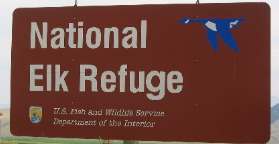
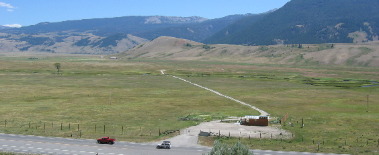
This
picture is of the middle section of the elk refuge. You can see the high fence
that runs along the highway north of Jackson.
OK
it is time to discuss whether it is Jackson or Jackson Hole! Trappers in the northern
Rockies in the 1820's and '30s gave the name "hole" to any high valley
surrounded by mountains. Davey Jackson was a trapper who spent a lot of time in
this valley trapping beaver. This area became known as Davey Jackson's Hole--later
becoming just "Jackson Hole." The valley (hole) is about 50-miles long
and 10-12 miles wide.
The town near the south end of "Jackson Hole",
is called Jackson. Thus there are places like the Information Center where you
can be in both Jackson and Jackson Hole. Now you know.
Elk were once found
throughout the forest and plains to the east of the Rocky Mountains. With the
westward push of settlement, the few elk that survived were those herds in the
mountainous areas. One of the largest herds that remained was the Jackson Hole
elk herd.
North of the town of Jackson in Jackson's Hole is the National
Elk Refuge. The Refuge provides a winter home for thousands of elk which spend
the summer in surrounding mountains. Elk stay on the refuge for about six months
each winter between late October and early May. In the summer months, elk can
be seen throughout Grand Teton and Yellowstone National Parks and in the Bridger
Teton National Forest. They are easily spotted at dawn and dusk when they emerge
from the forest to graze.
The elk is the second largest member of the deer
family. They are exceeded in size only by the moose. A large bull elk will average
about 650 pounds and will stand nearly 5' high. Although there are similarities
in general appearance, elk differ behaviorally from deer. In that they are more
social, organizing themselves into large herds.
Elk differ from deer in
eating habits as well. While deer are primarily browsers, eating young twigs,
shoots, leaves and buds, elk are mostly grazers and feed on grasses and sedges.
The
breeding, or rutting, season occurs in September and early October while elk are
in the high country. At this time the bugling sounds of the mature bulls fill
the mountains as they gather harems of cows and challenge rival bulls. During
the rut bulls vigorously defend their harems of up to 15-cows. The gestation period,
from conception to birth, is 8.5 months.
Twice each year the elk of Jackson
Hole participate in a vast migration that covers a large portion of northwestern
Wyoming. The elk summer habitat is the remote mountain ranges and farthest valleys
and meadows. Elk in the high country respond to the message carried by late autumn
snows. From the high plateaus of Southern Yellowstone Country, from Grand Teton
national Park and from the Teton Wilderness within the Bridger National Forest,
elk begin drifting down into Jackson Hole, headed for the National Elk Refuge.
By January, thousands of elk are feeding on the refuge lands visible from the
highway traversing the west side of the refuge. Some may have traveled more than
65 straight-line miles during migration.
In winter, the refuge hosts an
average of 7,000 elk, over half the total Jackson elk herd. Others winter in sheltered
feeding areas elsewhere, and in some winters a considerable number may stay off
the refuge. Elk are free to migrate to and from the refuge. In April, the instinctual
migration begins back to the high country. Normally, the bulls leave first, followed
a short time later by the cows, heavy with calves. The calves may be born on the
way to the high country.
When calves are strong enough, cows will move on
following the receding snow line. The herd remains scattered through the back
country until fall. When the aspen yellow on the slopes and the hint of winter
is in the air, elk begin to congregate and work their way back down into the valley.
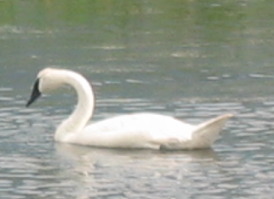
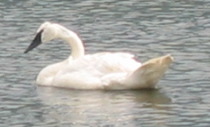
The
marsh area near the Information Center is the nesting and year-round home of the
rare trumpeter swan. In winter months as many as 60-90 trumpeter and tundra swans
find a haven on the National Elk Refuge because warm springs provide some ice-free
open waters.
By the early 1930's fewer than 100 trumpeter swans survived
outside of Alaska. They were driven to the most remote areas by market demand
for quill pens and powder puffs of swans down. Habitat loss additionally reduced
their numbers until only western Montana and the Yellowstone region sheltered
remnant populations of the largest of all North American waterfow.
In 1935,
a portion of the Centennial Valley in Montana was set aside as the Red Rock Lakes
National Wildlife Refuge to protect the nesting and wintering grounds of the trumpeter
swan. The refuge, along with areas protected by the boundary of Yellowstone national
Park preserved a nucleus of nesting swans. With Man's help, these birds expanded
their numbers and today, trumpeter swans nest and raise their young in Grand Teton
National Park and the National Elk Refuge north of Jackson.
Most of the
trumpeters in this area are not migratory. They spend their entire life within
a tri-state area along the borders of Wyoming, Montana, and Idaho. Despite the
hardships, the swans seem to be doing well and it is encouraging to know that
swans and their habitat are being protected.
The Jackson Hole elk
herd, numbering about 11,000 animals, is one of the outstanding natural resources
of this country. Approximately 7,500 of the elk winter on the 24,300 acre National
Elk Refuge, which is administered by the U.S. Fish and Wildlife Service and is
one of over 400 National Wildlife Refuges across the United States.
Elk
winter at the refuge for about 6-months each year, from November to May. They
paw through snow to feed on natural grasses and standing forage. Supplemental
feeding is necessary however, when natural forage is scarce, depleted or covered
by crusted snow and ice. Alfalfa hay pellets are fed each morning during the crucial
winter months by refuge employees using special tractors and trailers. The feed
maintains the large herd through the worst winter weather. The National Elk Refuge
is responsible for feeding the elk and furnishing the equipment. The refuge shares
equally in the cost of feed with the Wyoming Game and Fish Department.
During
the fall, elk are hunted on Federal forest lands as well as on certain areas of
the national Elk Refuge and Grand Teton National Park. Hunting is used as a management
tool to reduce elk numbers and control herd segments so that the overall population
of elk is compatible with limited winter range in the Jackson Valley.
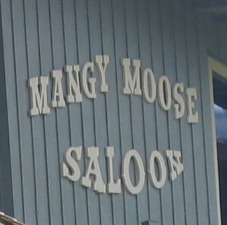
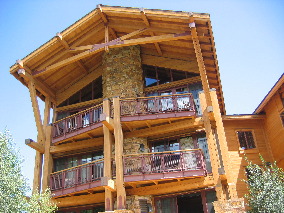
Teton
Village located on the west side of Jackson is an upscale resort built around
trendy shops and and a world class ski lift. The Mangy Moose Saloon is one of
those places that the younger set gravitate to in the evenings and where tour
busses stop for lunch.
Joyce had her dancing
shoes on while we were in Jackson and I can tell you, with certainty, that the
Million Dollar Cowboy Bar in Jackson will never be the same. VBG
Until next
time remember how good life is.
Mike & Joyce Hendrix